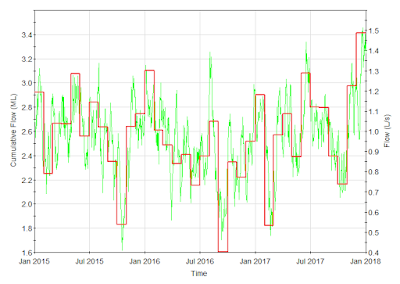Using GoldSim's built-in probabilistic simulation capabilities, it is straightforward to perform statistical analysis of time series data. An example model was built and added to our library, which demonstrates how Monte Carlo simulation is used to analyze daily time series data of streamflow to produce daily, monthly, and annual statistics. In addition to this, the model finds a best fit probability distribution for these statistics.
Showing posts with label data. Show all posts
Showing posts with label data. Show all posts
November 7, 2018
June 13, 2016
Using Arrays in GoldSim
Posted by Ryan Roper
One of the most powerful features of GoldSim is its support for vector and matrix data types, or arrays. Whether you are modeling different age cohorts in a population dynamics model or you need to calculate monthly and/or yearly flow totals in a water resource model, the use of arrays can reduce complexity in your model and help you calculate useful results. If you are developing a contaminant transport model, using arrays is unavoidable since species properties are stored in vectors.
Proficiency with arrays in GoldSim is essential for many applications. Gaining a rudimentary understanding will require that you at least know how to create and use array label sets (named and indexed) and how to reference values in an array. I would definitely encourage you, though, to go beyond a basic proficiency and take advantage of the advanced capabilities that GoldSim provides. This blog post will point you to resources to help you get familiar with and start using arrays in GoldSim. I will highlight some example applications that range from very basic usage of arrays to sophisticated applications involving the use of array constructors.
 |
| Monthly cumulative flow results (see webinar 'Introduction to Arrays') |
Proficiency with arrays in GoldSim is essential for many applications. Gaining a rudimentary understanding will require that you at least know how to create and use array label sets (named and indexed) and how to reference values in an array. I would definitely encourage you, though, to go beyond a basic proficiency and take advantage of the advanced capabilities that GoldSim provides. This blog post will point you to resources to help you get familiar with and start using arrays in GoldSim. I will highlight some example applications that range from very basic usage of arrays to sophisticated applications involving the use of array constructors.
December 23, 2015
Time Series: Modeling Changing Amounts Over Periods
Posted by Jason Lillywhite
A common modeling requirement in GoldSim is to represent movement of (or changes in) amounts of material over time intervals. Common examples we have seen from our users are flows through a pipe, site runoff, and rainfall amounts. Representing this type of data can be challenging if you are not used to GoldSim's way of explicitly defining data in the Time Series element. I think a reason for this is due to our familiarity with spreadsheets, which do not require explicitly defining how the data is represented.
A common modeling requirement in GoldSim is to represent movement of (or changes in) amounts of material over time intervals. Common examples we have seen from our users are flows through a pipe, site runoff, and rainfall amounts. Representing this type of data can be challenging if you are not used to GoldSim's way of explicitly defining data in the Time Series element. I think a reason for this is due to our familiarity with spreadsheets, which do not require explicitly defining how the data is represented.
Subscribe to:
Posts (Atom)

